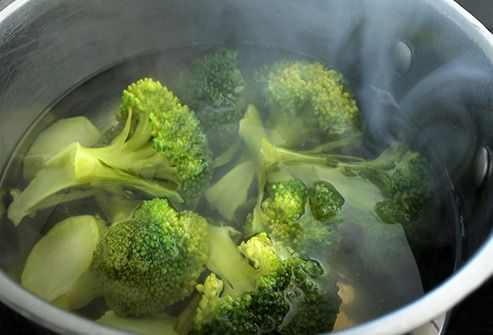
|
SLIDESHOW |
|
13 Foods You're Eating All Wrong (
courtecy;-webMD)
|
Could You Be Eating These Foods Wrong?

1/15
How Matters, Too
Yes, eating healthy
means choosing the right foods, but that's only part of it. For example, the
skin of many fruits and veggies (or just under it) is where a lot of the
vitamins and minerals are, so when you peel it off, you're missing out. Find
out what you can do to get the most nutritional value out of what you put in
your mouth.

1/15
Broccoli
Steam it. That's the
best cooking method if you want to get the most bang per bite. Boiling,
microwaving, and stir-frying all break down more vitamin C, chlorophyll,
proteins, and other nutrients. And the shorter the cooking time, the more
nutrients you save. To add flavor, dress up steamed broccoli with a little
olive oil, sea salt, and lemon juice.

1/15
Potatoes
When cooled to room
temperature or chilled in potato salad, they'll have more "resistant
starches," which take longer to digest. These help keep your gut healthy
and may lower your chances of obesity, colon cancer, and diabetes.

1/15
Eggs
In just around 75
calories, one egg gives you about 6 grams of high-quality protein, all nine of
the essential amino acids your body needs, and lots of vitamin D (which is hard
to get from food). But all that goodness gets offset when you cook it in fat
and add a pile of pancakes dripping in butter and syrup with a side of bacon
and hash browns. Try your egg poached with some sauteed spinach, or hard-boiled
on whole-grain toast.

1/15
Water
Bottled water is fine
for staying hydrated, but it probably doesn't have enough of one important
ingredient to keep teeth strong and help prevent tooth decay: fluoride. The
stuff from your tap usually does. Almost all dental and public health organizations
support adding the mineral to public drinking water. The CDC calls it a top-10
achievement for public health in the 20th century.

1/15
Cabbage
Turn it into sauerkraut
or kimchi. Fermented foods like this, made when bacteria feed on sugars in the
vegetable, have natural probiotics that nourish the bacteria in your
gut. They may help protect against cardiovascular disease, cancer, and
diabetes. (But if you're concerned about heart health or high blood pressure,
sauerkraut has more sodium than raw cabbage.)

1/15
Fruit
Better to chew your
fruit and drink water when you're thirsty, especially if you're already
overweight or have diabetes. Even 100% pure juice loses nutrition when it's
processed. Juice also doesn't have the fiber that gives you a feeling of
fullness and slows the absorption of sugar into your system. Regular sugar
spikes from fruit juice can lead to health problems like diabetes, obesity, and
liver damage.

1/15
Canned Veggies
You don't want to cook
them twice. Canning is a surprisingly good way to keep the nutrition and
freshness in your veggies, but they do get cooked in the process. So after you
take them out, you only need to heat them long enough to warm up again. Longer than
that can damage flavor, texture, and nutrients.

1/15
Red Meat
It's a great source of
protein, omega-3 fatty acids, vitamin B12, niacin, zinc, and iron. The problem
is that it can also be loaded with saturated fat, which should only make up a
small part of your diet. Choose lean cuts, and trim all the fat you can see off
your meat before you cook it.

1/15
Coffee
Along with the caffeine
boost you get, its antioxidants help protect your cells. It can be a
low-calorie choice instead of sugar-sweetened soft drinks -- but only if you
avoid the syrup, sugar, and cream added to some coffees. Stick with the basic brew,
and pass on the "double-caramel-frappe-mocha-latte-chino" served in a
bucket-sized cup.

1/15
Pasta
Overcooked pasta gets
mushy and has a higher glycemic index (GI), which means your body absorbs the
carbs faster. Slightly springy "al dente" pasta tastes better and is
better for you. Drain it soon after it loses the outer crunch, even if there's
still a trace of darker yellow inside. The type of pasta will affect its cook
time. Start testing for doneness before the earliest time recommended on the
package.

1/15
Tomatoes
The powerful antioxidant
lycopene found in tomatoes helps protect against cancer, heart disease, stroke,
and other problems. And it's easier to get from cooked (think canned tomatoes
and long-simmered sauces) rather than raw fruits. However you eat them, add a
little olive oil: The fat helps your body absorb the phytonutrient.

1/15
Cantaloupe
Even though you aren't
going to eat the rind of this melon, you should give it a good scrub with a
produce brush before you slice into it. You want to get rid of dirt and
bacteria that could be trapped in the rough skin, so you don't spread germs
onto the flesh as you cut. Unlike other fruits, there's not enough natural acid
to kill them off. Keep whole cantaloupe as well as the pieces in the fridge.

1/15
Red Wine
The idea that it can
help protect your health appears to be true -- in moderation. More than a drink
a day for women, two for men, sends the effects in the other direction, though.
Heavy drinking can damage the liver and heart, harm an unborn child, and make
you more likely to get some kinds of cancer.
This tool does not provide medical advice
মন্তব্যসমূহ
একটি মন্তব্য পোস্ট করুন